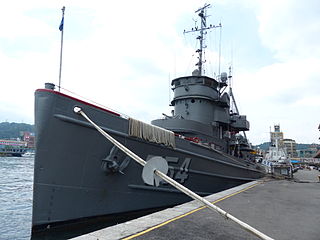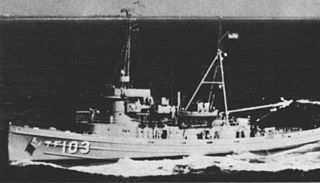
USS Abnaki (ATF-96) was the lead ship of the Abnaki class of fleet ocean tugs in the service of the United States Navy, named after the Abenaki tribe of Native Americans. She was laid down on 28 November 1942 at Charleston, South Carolina by Charleston Shipbuilding & Drydock, launched on 22 April 1943, sponsored by Mrs. James Mayon Jones, and commissioned at the Charleston Navy Yard on 25 November 1943. Abnaki earned three battle stars for service during the Korean War and 10 battle stars during the Vietnam War.

USS Achomawi (AT-148/ATF-148) was an Abnaki-class fleet ocean tugs in the service of the United States Navy, and was named for the Achomawi tribe of Native Americans.

USS Munsee (AT/ATF-107) was an Abnaki-class fleet ocean tug. She is the only ship of the United States Navy to hold the name Munsee, which is the name of a subtribe of the Delaware Indians, still living in Wisconsin and Kansas.
USS Arikara (AT-98) was an Abnaki-class of fleet ocean tug. It was named after the Arikara, a loose confederacy of sub-tribes of American Indians related to the Pawnee. The Arikara inhabited villages in the Missouri River valley.

USS Cree (AT/ATF-84), a Cherokee-class fleet tug, was a ship of the United States Navy named for the Cree, an indigenous people of North America whose people range from the Rocky Mountains to the Atlantic Ocean.
USS Tekesta (AT-93) was Navajo-class fleet tug built during World War II for the United States Navy. Shortly after being built, it was crewed by trained Navy personnel and sent into the Pacific Ocean to provide tug service to damaged ships in battle areas. For successfully performing this dangerous work, she was awarded four battle stars by the war's end.
The second USS Bluebird (ASR-19) was a Penguin-class submarine rescue ship in the United States Navy.

USS Chickasaw (AT-83/ATF-83) was a Navajo-class fleet tug constructed for the United States Navy during World War II. She served in the Pacific Ocean in World War II and the Korean War, and was awarded six battle stars for World War II and two battle stars during the Korean War.

USS Lipan (AT-85) was a Navajo-class fleet tug constructed for the United States Navy during World War II. Her purpose was to aid ships, usually by towing, on the high seas or in combat or post-combat areas, plus "other duties as assigned." She served in the Pacific Ocean during World War II and the Korean War. She was awarded two battle stars for World War II and four battle stars for the Korean War.

USS Yuma (AT-94/ATF-94/T-ATF-94) was a Navajo-class fleet tugboat constructed for the United States Navy during World War II. She was the second U.S. Navy ship named for the Yuma tribe of Arizona.

USS Shackle (ARS-9) was a Diver-class rescue and salvage ship commissioned by the U.S. Navy for service in World War II. She was responsible for coming to the aid of stricken vessels.

USS Conserver (ARS-39) was a Bolster-class rescue and salvage ship acquired by the U.S. Navy during World War II. Her task was to come to the aid of stricken vessels.

USS Athanasia (AF-41) was an Adria-class stores ship in service with the United States Navy in 1945. She was sold into commercial service in 1977.
USS Arapaho (AT-68/ATF-68) was a Navajo-class fleet ocean tug which served the U.S. Navy during World War II with her towing services. She was assigned initially to support the U.S. Atlantic Fleet, and was eventually assigned to support Allied forces in the war zones of the Pacific Ocean, resulting in her crew returning home after the war with four battle stars to their credit.

USS Apache (AT-67/ATF-67) was a Navajo-class fleet tug, later fleet ocean tug, in commission in the United States Navy from 1942 to 1946 and from 1951 to 1974. She saw service in World War II, the Korean War, and the Vietnam War.

The USS Pinola (ATA-206) was a Sotoyomo-class auxiliary fleet tug launched in 1945 and serving until 1956. The ship was transferred to the Republic of Korea in 1962.

USS Serrano (ATF-112) was an Abnaki-class tug of the United States Navy. She was laid down on 6 March 1943 by the United Engineering Co., Alameda, California, United States, and launched on 24 July 1943, sponsored by Mrs. Sidney E. Fraser. Serrano was commissioned on 22 September 1944. After six years of service, Serrano was decommissioned in 1950. After spending ten years in reserve, she was reactivated, converted to a surveying ship and re-designated AGS-24. She served in that role until 1970.

USS Molala (AT-106/ATF-106) was a US Navy Abnaki-class tugboat, named after the Molala people of Oregon.

USS Hitchiti (ATF-103) was Abnaki-class tugboat during the World War II, Korea and Vietnam. The ship was later sold to Mexico as ARM Chac (R-55). Her namesake is a tribe of Creek Indians who lived in Florida and Georgia. The word "Hitchiti" means "to look up the stream."

USS Jicarilla (ATF-104) was Abnaki-class tugboat during the World War II. The ship was later sold to Colombia as ARC Sebastián De Belalcázar (RM-73). Her namesake is a group of the Apache tribe found in the southwestern United States.















